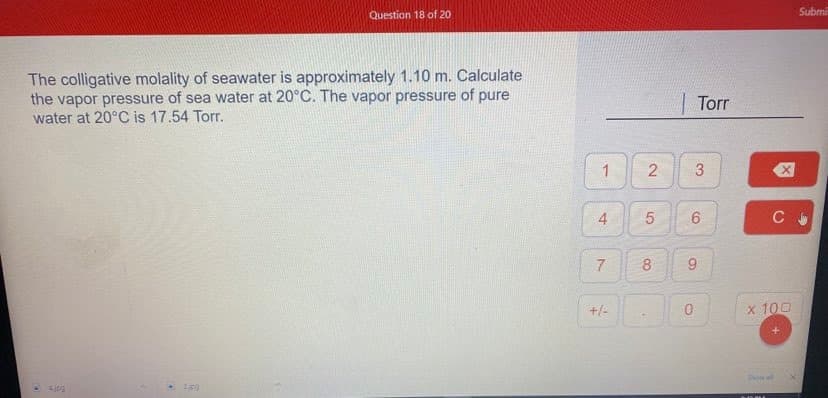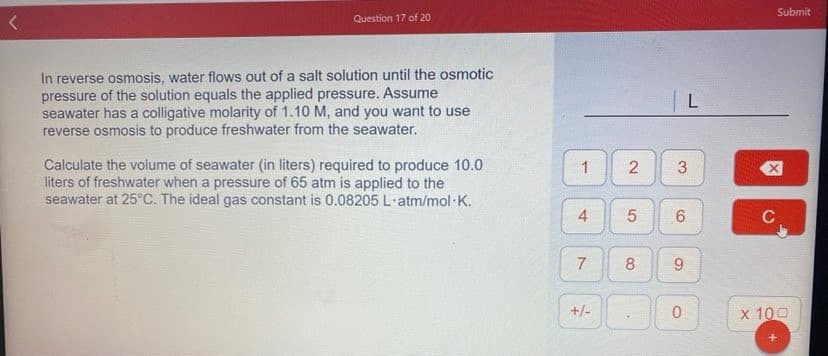The colligative molality of seawater is approximately 1.10 m. Calculate the vapor pressure of sea water at 20°C. The vapor pressure of pure water at 20°C is 17.54 Torr.
The colligative molality of seawater is approximately 1.10 m. Calculate the vapor pressure of sea water at 20°C. The vapor pressure of pure water at 20°C is 17.54 Torr.
Chemistry: Principles and Reactions
8th Edition
ISBN:9781305079373
Author:William L. Masterton, Cecile N. Hurley
Publisher:William L. Masterton, Cecile N. Hurley
Chapter10: Solutions
Section: Chapter Questions
Problem 68QAP: Consider two solutions at a certain temperature. Solution X has a nonelectrolyte as a solute and an...
Related questions
Question

Transcribed Image Text:Question 18 of 20
Submi
The colligative molality of seawater is approximately 1.10 m. Calculate
the vapor pressure of sea water at 20°C. The vapor pressure of pure
water at 20°C is 17.54 Torr.
| Torr
3
4
C
8
9.
+/-
x 100
Show al
2.

Transcribed Image Text:Submit
Question 17 of 20
In reverse osmosis, water flows out of a salt solution until the osmotic
pressure of the solution equals the applied pressure. Assume
seawater has a colligative molarity of 1.10 M, and you want to use
reverse osmosis to produce freshwater from the seawater.
Calculate the volume of seawater (in liters) required to produce 10.0
liters of freshwater when a pressure of 65 atm is applied to the
seawater at 25°C. The ideal gas constant is 0.08205 L·atm/mol K.
1
3
C
8
+/-
x 100
2.
4-
7.
Expert Solution
This question has been solved!
Explore an expertly crafted, step-by-step solution for a thorough understanding of key concepts.
This is a popular solution!
Trending now
This is a popular solution!
Step by step
Solved in 3 steps

Knowledge Booster
Learn more about
Need a deep-dive on the concept behind this application? Look no further. Learn more about this topic, chemistry and related others by exploring similar questions and additional content below.Recommended textbooks for you

Chemistry: Principles and Reactions
Chemistry
ISBN:
9781305079373
Author:
William L. Masterton, Cecile N. Hurley
Publisher:
Cengage Learning

Chemistry: The Molecular Science
Chemistry
ISBN:
9781285199047
Author:
John W. Moore, Conrad L. Stanitski
Publisher:
Cengage Learning

Principles of Modern Chemistry
Chemistry
ISBN:
9781305079113
Author:
David W. Oxtoby, H. Pat Gillis, Laurie J. Butler
Publisher:
Cengage Learning

Chemistry: Principles and Reactions
Chemistry
ISBN:
9781305079373
Author:
William L. Masterton, Cecile N. Hurley
Publisher:
Cengage Learning

Chemistry: The Molecular Science
Chemistry
ISBN:
9781285199047
Author:
John W. Moore, Conrad L. Stanitski
Publisher:
Cengage Learning

Principles of Modern Chemistry
Chemistry
ISBN:
9781305079113
Author:
David W. Oxtoby, H. Pat Gillis, Laurie J. Butler
Publisher:
Cengage Learning

Chemistry: Principles and Practice
Chemistry
ISBN:
9780534420123
Author:
Daniel L. Reger, Scott R. Goode, David W. Ball, Edward Mercer
Publisher:
Cengage Learning

Chemistry
Chemistry
ISBN:
9781305957404
Author:
Steven S. Zumdahl, Susan A. Zumdahl, Donald J. DeCoste
Publisher:
Cengage Learning
